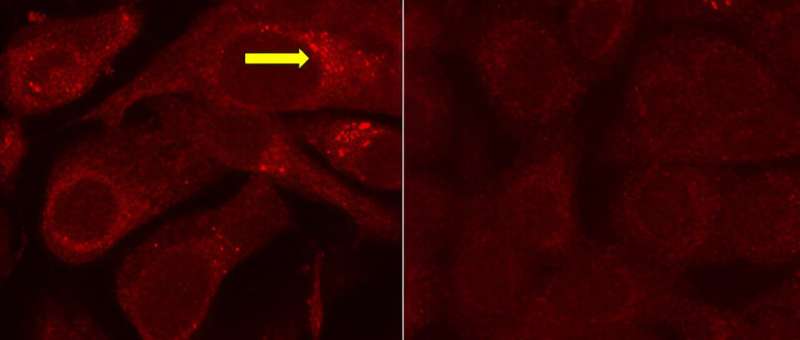This article has been reviewed according to Science X's editorial process and policies. Editors have highlighted the following attributes while ensuring the content's credibility:
fact-checked
trusted source
proofread
Lung cancer cells protected from cigarette smoke damage, researchers find

Lung cancer cells survive better and exhibit less cell damage when exposed to cigarette smoke in cell culture experiments compared to non-cancerous lung cells. New research by a team of undergraduate students led by a Penn State molecular biologist may have revealed how lung cancer cells can persist in smoke. The mechanism could be related to how cancer cells develop resistance to pharmaceutical treatments as well.
The team found that a protein, which is expressed at high levels in some lung cancer cells and acts as a pump to transport molecules across the cell membrane, could potentially be clearing the damaging molecules coming from cigarette smoke. These molecules, if left uncleared inside the cells, can lead to protein aggregation that can damage and eventually kill lung cells.
A paper describing the research appeared in PLOS One.
"Cigarette smoke contains carcinogenic compounds, such as hydrocarbons and reactive oxygen and nitrogen species, that can damage cells in various ways," said Maria Krasilnikova, associate research professor of biochemistry and molecular biology in the Eberly College of Science at Penn State and the lead author of the paper. "One way these compounds can damage cells is by causing proteins to misfold, which can lead to the formation of protein aggregates."
Protein aggregates can gum up the inner workings of the cell and eventually lead to cell death, the researchers explained. These aggregates have been implicated in several neurodegenerative diseases, such as amyotrophic lateral sclerosis, Alzheimer's, and Parkinson's, and also in cancer progression, emphysema, and chronic obstructive pulmonary disease.
The researchers first compared the level of protein aggregation between a lung cancer cell line and non-cancerous cells when grown in a culture that contained cigarette smoke condensates. They found that after 24 hours of exposure to cigarette smoke, the cancer cells had lower levels of protein aggregates than non-cancerous cells from a monkey kidney cell line and two human lung cell lines.
"We then looked at how the cells grew and survived in various concentrations of cigarette smoke condensates over seven days," Krasilnikova said. "Amazingly, the cancer cells could continue to grow in about 10 times the concentration of cigarette smoke than the non-cancerous cells. So, we wanted to investigate how the cancer cells were able to maintain this growth in a toxic environment at a mechanistic level."
The research team focused on the role of a cell surface pump, called ABCG2, that was known to be highly expressed in the lung cancer cell line and has also been associated with breast cancer.
"We observed that the cancer cells were difficult to stain with a fluorescent blue dye that we use to stain DNA to help us see the cells," Krasilnikova said. "ABCG2 had been shown to pump the dye out of cells, so we knew it must be highly active in these cells and hypothesized that it might also pump the carcinogenic compounds from cigarette smoke out of the cells."
To test this hypothesis, the research team inhibited the activity of ABCG2 in the cancer cells in two ways and tested how the cells then reacted to cigarette smoke exposure. They used febuxostat, a medication used to treat gout and a known inhibitor of ABCG2 activity, and, separately, downregulated ABCG2 using a genetic method called RNA interference. In both cases, they saw an increase in protein aggregation in the cancer cells when ABCG2 was inhibited.
"It seems clear that ABCG2 plays an important role in how the cancer cells were able to maintain lower levels of protein aggregation and grow and survive better when exposed to cigarette smoke," Krasilnikova said. "We think it must be doing this by pumping the carcinogenic compounds from cigarette smoke out of the cells, allowing them to survive in the toxic environment."
Cell surface pumps, including ABCG2, have also been implicated in the development of multidrug resistance in cancers, presumably by pumping the damaging chemotherapy drugs out of cancer cells.
"It is well known that smoking during cancer treatment worsens the prognosis," Krasilnikova said. "This could be due to a shared mechanism in the cancer cells that allows them to survive better in toxic environments. Our results suggest that the increase in ABCG2 activity in cancer cells, as well as other similar pumps, is likely to be one of these mechanisms."
More information: Emmanuella O. Ajenu et al, ABCG2 transporter reduces protein aggregation in cigarette smoke condensate-exposed A549 lung cancer cells, PLOS ONE (2024). DOI: 10.1371/journal.pone.0297661


















